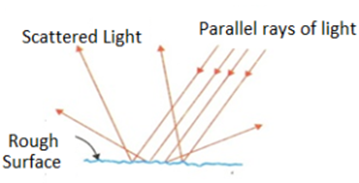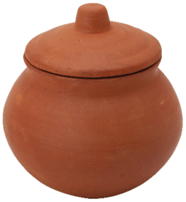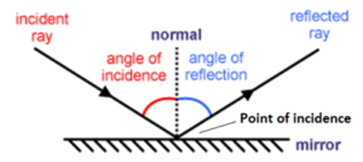Science > Physics > Optics > Reflection of Light > Introduction to Reflection of Light
When a ray of light approaches a smooth polished surface and the light ray bounces back, it is called the reflection of light. The surface which reflects the light is called a reflecting surface. The ray of light approaching the reflecting surface is called the incident ray. The ray bounced back and moving away from the reflecting surface is called the reflected ray.
Diffusion Reflection:

In this type of reflection, the incident ray of light strikes a surface and the light is scattered after reflection. Reflected rays move in many directions. The angle of incidence and angles of reflection are different. A perfectly diffusing surface is one for which luminance is independent of the direction of observation. e.g. reflection from paper, unpolished clay pot.

Regular Reflection:
In regular reflection, a parallel beam of incident light is reflected as a parallel beam in one direction. In this case, parallel incident rays remain parallel even after reflection and go only in one direction. Surfaces showing regular reflection appear bright only in one direction only for the given position of the eye. A surface which reflects regularly nearly all the light incident on it is called a mirror.

The objects having a shiny or polished surface reflects more light compared to the objects having a dull or unpolished surface. Silver metal is the best reflector of light. Hence plane mirror is made by depositing a thin layer of silver metal on one side of a plane glass sheet. The silver coating is protected by red paint. e.g. mirror, polished metal surface, polished pots

Water at glazing incidence (i = 90°) is a good reflector. Hence we can see images of the sun and nearby trees in the river in the morning and evening but not at noon. If the sea is observed from an airplane the part of the sea exactly below appears dark but that part at the horizon appears shiny.
Terminology of Reflection:

- Incident Ray: The ray of light falling on the surface of a mirror is called incident ray.
- Point of Incidence: The point at which the incident ray touches the mirror surface is called the point of incidence.
- Reflected Ray: The ray of light which is sent back by the mirror from the point of incidence is called reflected ray.
- Normal: A line perpendicular to the mirror surface at the point of incidence is called normal.
- Angle of incidence:
- The angle made by the incident ray with the normal is called the angle of incidence.
- Angle of Reflection:
- The angle made by the reflected ray with the normal at the point of incidence is called the angle of reflection.
- Object: Anything which gives out light with off its own of reflected by it is called an object.
- Image: When the light rays coming from an object are reflected from a mirror then an optical appearance which is produced by the mirror is called an image. Images are of two types, real image, and virtual image.
- Real Image: The image which can be seen on the screen is called a real image.
- Virtual Image: The image which cannot be obtained on a screen is called a virtual image.
- Lateral Inversion: The change of sides of an object in its mirror image is called lateral inversion. It happens due to the reflection of light. In this case, the right side of the object becomes left side of the image and the left side of the object becomes the right side of the image
Laws of Reflection:
- The angle of incidence is equal to the angle of reflection
- The incident ray and the reflected ray lie on either side of the normal at the point of incidence
- The incident ray, reflected ray and the normal at the point of incidence lie in the same plane.
Image of Point in a Plane Mirror:

Theory:

XY is a reflecting surface and A is a point source of light(object) emitting light in all the directions. AO is normal to the reflecting surface XY. Ray AP is incident on the surface XY at an angle of inclination i, and reflected ray is ray PB. PN is normal to surface XY at P.
∠ APN = ∠ PAO = i (alternate angles)
∠ OA’P = ∠ NPB = i (corresponding angles)
In Δ AOP and Δ A’OP
∠ AOP = ∠ A’OP (Each 90°)
∠ OA’P = ∠ OAP (each equal to i)
OP is a common side
∴ Δ AOP ≅ Δ A’OP
∴ OA’ = OA
Conclusions:
- The image of a point in a plane mirror lies behind the mirror along the normal produced from the object and is as far behind the mirror as the object is in front.
- The image is virtual and erect. The image is virtual because the rays of light are not coming from it but appear to come from it.
Image of an Extended Object in a Plane Mirror:

Let us consider an object AB in front of the mirror as shown. The plane of the mirror is perpendicular to the plane of the paper (screen). As per the image of a point in a plane mirror, point A’ is an image of point A and point B’ is an image of point B. Hence A’B’ is the image of the object AB.
Generally, plane mirrors are put in the vertical plane, there is a lateral inversion of the image. Thus the image formed is virtual, erect, as the same size of object, laterally inverted, and is as far behind the mirror as the object is in front.
Rotation of Mirror:

A ray of light is incident on a mirror at the angle of incidence i and is reflected back at the angle of reflection r = i. Thus there is a deviation of the ray is (180° – 2i). Let the mirror be rotated through angle θ keeping the direction of incident ray same. Then angles of incidence and deviation become (i + θ) and (180° – 2(i + θ)).
The change in direction of incident ray = (180° – 2i) – (180° – 2(i + θ))
The change in direction of incident ray = 180° – 2i – 180° + 2i + 2θ = 2θ
Thus if the mirror itself is rotated by θ, then reflected ray turns through angle 2θ
Inclined Mirrors:
Mirrors Perpendicular to Each Other:
If the two mirrors are perpendicular to each other, then the ray suffers one reflection each at the two mirrors and the final reflected ray (emergent ray) is antiparallel to the incident ray.

The object O will give image I1 in mirror M1 and image I2 in mirror M2. Now image I1 is an object for extended mirror M2 its image in M2 is I3. Now image I2 is an object for extended mirror M1 its image in M1 is I4. The images I3 and I4 coincide. Thus three images are formed I1, I2, and I3(or I4).

Mirrors at angle 60° With each Other:

Number of Images in Inclined Mirrors:
If θ is the angle between the mirrors, then find quantity 360/θ = n (say). If the value of n is even then the number of the image is (n -1) (it is true for both symmetrical and unsymmetrical position of the object)
If the value of n is even then the number of the image is n for the symmetrical position of the object and (n – 1) for the unsymmetrical position of the object If n is fraction number of images are equal to integer part.
|
Sr.No. |
Angle Between mirrors (θ) |
360°/θ |
Images Formed When Object Placed |
|
|
Asymmetrically |
Symmetrically |
|||
|
1 |
0° |
– |
Infinite |
Infinite |
|
2 |
30° |
12 (Even) |
11 |
11 |
|
3 |
45° |
8 (Even) |
7 |
7 |
|
4 |
60° |
6(Even) |
5 |
5 |
|
5 |
72° |
5 (odd) |
5 |
4 |
|
6 |
75° |
4.8 |
4 |
4 |
|
7 |
90° |
4(Even) |
3 |
3 |
|
8 |
112.5° |
3.2 |
3 |
3 |
|
9 |
120° |
3(odd) |
3 |
2 |

3 replies on “Introduction to Reflection of Light”
good notes and they were helpful
This note was interesting and was really helpful as it explains every part in detail. Thank you guys!!I appreciate it a lot.
Well coordinated. Thanks 🙏